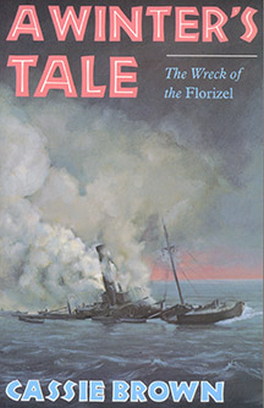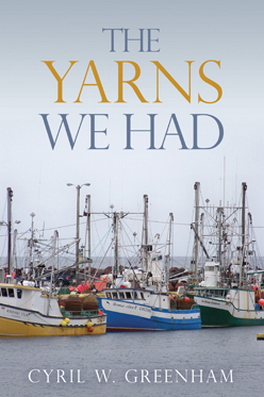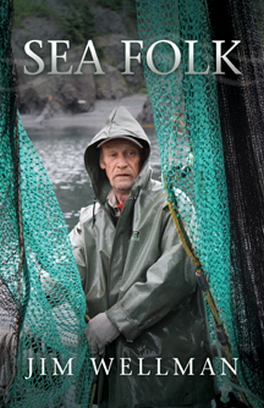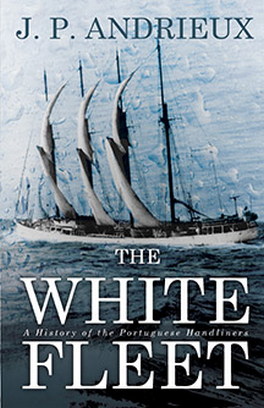“Hope dies hard with a sailor.” — W. B. Cullen, mate of the Roanoke, 1909 Globe and Mail bestselling author Robert C. Parsons presents more than fifty exciting stories of high-seas adventure! Set mainly along the shores of Newfoundland and Labrador in the 1800s and 1900s, these are true stories of men and women who faced the deadly Atlantic Ocean—and won. Featuring: Ann Harvey of Isle aux Morts, a teenaged girl who helped rescue 160 passengers of the doomed brig Dispatch in 1828 George Lake of Fortune, captain of the schooner George Ewart, who narrowly escaped death when an iron steamer smashed into his vessel off the coast of Spain in 1917 Captain Frank Poole of Belleoram and crew of the schooner Dorothy P. Sarty, who in 1954 were shipwrecked and rowed twenty-five miles to shore in a lifeboat . . . and even refused a lift from a passing coal carrier Captain Arthur Jackman of Renews and crew of the Plover, who in 1890 were at death's door after the sinking of their steamship but were rescued in the nick of time Henry Taylor of Newfoundland, captain of the barque Constance, who in 1884 was awarded by the Italian Admiralty for rescuing three Italian harbour pilots The forty-six men and seventeen women who miraculously escaped the wreck of the steamer Capulet after it went aground at St. Shotts in 1896 . . . and many more!
In the mid-summer of 1828, the brig Dispatch, bound for Quebec with over 200 people aboard, crew and passengers, struck a rock about three miles from Isle aux Morts. The three words “struck a rock” seem innocent enough, but within the event lies a Newfoundland and Irish tale of courage in the face of death at sea.
In essence there were two groups of heroes that converged between July 10, the day of the wreck, and July 13–16, when many of the Dispatch’s complement were rescued, one example being a fisherman and his family who lived at Isle aux Morts. Located about ten kilometres east of Port aux Basques, its name is French for Isle of the Dead, probably in reflection of the many wrecks that had occurred there.
This livyer family was George Harvey, a fisherman in his fifties, and his son (unnamed, but believed to be Tom or John), aged twelve, and his sixteen- or seventeen-year-old daughter, Ann. According to the Newfoundland paper the Times (January 2, 1833) George’s daughter was “at that time a delicate girl.”
It has also been relatively well documented that the Harveys’ dog was part of the team of heroes. Even the heroine herself has two spellings of her name, with the predominate version being “Ann.”
No less courageous on that day were the Irish (with a few Scottish) immigrants and the crewmen of the Dispatch, thrown into shipwreck panic on a foreign and strange barren shore.
The brig left the port of Londonderry, Ireland, on May 29, 1828. On board, under the command of Captain William Lancaster, were ten crewmen and around 200 passengers. The Dispatch’s mate said later (as Lancaster died in the wreck), approximately 200, since several newborn infants were not listed, as passage money for them had not been paid.
Details of the brig itself are scanty, but records from nearly 200 years ago show it was registered in Workington, England, and was engaged in 1828 to carry Irish immigrants to a new life in Canada. The name itself has evolved over the years to “Despatch.” However, newspapers of the day state Dispatch (notably the September 2, 1828, edition of the Strabane Morning Post).
The voyage westward was relatively summer-smooth and uneventful, but on the Grand Banks, the Dispatch sailed into thick fog, which persisted all along Newfoundland’s south coast. Early in the morning of Thursday, July 10, in the midst of a strong southeast gale and high seas, Lancaster changed course toward what he thought was the entry into the Gulf of St. Lawrence.
This miscalculation put the brig near Wreck Rock, about three miles offshore from Isle aux Morts. The lookout shouted, “Breakers ahead,” but despite orders to change course, it was too little and too late.
Initial attempts to rescue people ended in disaster. There were not enough lifeboats for all, but the first one launched overturned, drowning all aboard, including the captain. Other desperate attempts were barely successful: a few people made it to shore; others reached a nearby scrub-covered island; a few clung to the crumbling Dispatch.
Approximately fifty people died in the next two or three days. Again, the exact number is unclear, as some were very young children or newborns. Basically the survivors—men, women, and children—were alone in an uninhabited area, with no shelter, no food or water, no communication with any of the sparsely settled villages of Newfoundland’s south coast. Many of those who reached a rock or shore had very light or little clothing.
Two days after the wreck, just at sundown, George Harvey, who lived at the eastern entrance to Isle aux Morts, spotted wreckage. Because the wind had shifted southeast, i.e. onshore, a keg, a small pallet of straw, and freshly broken ship’s timbers drifted in near his home.
He knew from past experience some vessel was in trouble. Owing to the lateness of the day and strong winds and seas, he returned home. On the other hand, before he slept he put a plan in place for rescue, if indeed there were people in danger.
Early Sunday morning, July 13, he and his two children put their twelve-foot boat to sea, intending to row to Wreck Rock (so named after the wreck of the Dispatch).
Meanwhile, in the intervening two days, the long-suffering Irish and Scottish immigrants were in big trouble. Several of their tales of courage, heroism, and determination have trickled down through the years.
One family of six was swept off a rock after they had obtained footing on it; four men and ten children died on the rock from starvation and exposure; five children and one woman died on the mainland beach; four men perished in the woods; and one woman and a boy died in one of the Dispatch’s boats as its rowers tried to reach shore.
One of the survivors, Daniel Arnot of Argyllshire, Scotland, in a petition to the governor of Durham County, Upper Canada, where he later lived, said:
We [he, his wife, and eleven children] emigrated to Canada on the brig Dispatch and had considerable property with us, but on July 10 the vessel struck on a rock called Cap Rue about four miles from land and became a total wreck. Everything on board was lost and we were on the rock six days and nights without anything to sustain us when accidentally we were observed by the HMS Tyne Frigate, who took all who remained alive on board.
We were conveyed to Halifax in a helpless state. We remained there until the family recruited in strength when the Brig King Fisher removed us to Quebec from thence to Upper Canada.
Thus was the Arnot family, reduced to poverty, appealing to the governor for help. A few years later, a brief story of the wreck came from Reverend Andrew Halley, who in 1855 married Daniel Arnot’s daughter, Mary:
Mrs. Arnot gave her stockings to help fill a hole in the hull. She carried her baby Mary in her skirt held in her teeth as she went by safety rope to shore above the waves.
Of course, “safety” was a relative word, as many survivors were now perched on an exposed rock without food or water. Although it was July, hunger, thirst, and inclement weather reduced these scores and scores of people to near death.
The newspaper Strabane Morning Post of September 2, 1828, said, “By a comparison of numbers, it appears that thirty-six at least were drowned.” Others, especially the very young, died of exposure or drowning.
Prior to arrival of the brig Tyne, six days after the wreck, George Harvey and family had sprung into action.
That Sunday morning—three days after the wreck and his discovery of flotsam from the Dispatch—he, Ann, and his young son rowed to the wreck site. According to the newspaper (which had received the news from the Tyne in early September, seven weeks after the wreck), Harvey could only get to the rock and wreckage by waiting for opportunities in a lull in surf, wind, and tide:
. . . it was only by watching the occasional fall of the surf for a few hours each day, till the following Tuesday, that the mate and crew [of the Tyne] with two boats, and the assistance of a fisherman in a small boat of twelve feet, saved those in the accompanying list.
Curiously enough, the role of the Harveys is downplayed in the report of the HMS Tyne. Naturally enough, in retrospect, as His Majesty George IV would have been impressed by a favourable and significant account by the Tyne’s officers.
Throughout the next three days—all day Sunday, July 13, to Tuesday, July 15—George and Ann, though delicate in health, rowed back and forth from the wreck site to their home, taking whatever the little boat could hold. Additionally, George and helpers had to rest, plus watch for openings in surf and weather to make the life-preserving dashes.
Accordingly, he did not have time or opportunity to rescue all 192 people. Documentation shows the HMS Tyne, under the command of Sir Richard Grant, showed up on the evening of the sixth day after the wreck, July 15, and took off the remaining people, now more dead than alive. Daniel Arnot and family were some of those found by the Tyne. Whether the Tyne inadvertently arrived at the site or had heard of the news while harbouring at nearby Port aux Basques is not clear.
Captain Grant, eight days later and perhaps after he had landed his load of survivors, went back to the village of Isle aux Morts to find there was “not a particle of food” in the Harveys’ little home. He wrote, “I found fifty men, thirty women, and eleven children in the most wretched condition, many of them barely covered with the clothes washed on shore from the wreck . . .”
Much of the Harvey role in rescue is preserved in family and local lore, but George Harvey also explained what happened to visiting clergy. In September 1839, the Reverend William Marshall visited the Harveys and wrote:
This morning [September 7, 1839] I read Prayers and preached in Mr. Harvey’s house and baptized two children and was afterwards carried by Mr. Harvey and one of his daughters in a punt to Burnt Islands, a place four miles from the former.
On our way down Mr. Harvey pointed to the Rock on which a large Brig was lost in 1828 named the Dispatch with 200 passengers on board, 160 of whom Mr. H. and his daughter succeeded in carrying from the Rock on which the Vessel had struck. Some of the poor creatures lived on this rock for eight days [sic] with scarcely any food or clothing . . .
Visiting clergyman Archdeacon Edward Wix also wrote down what he heard of the Harveys’ exploits. “On a rock, three miles from their residence they discovered such of the passengers, who were not drowned, clinging together as they described it, like seabirds, the rock being only large enough to hold them.”
None of the rescue accounts in newspapers of the day mention a dog. However, Judge Daniel W. Prowse wrote of the loss of the Dispatch in Cornhill Magazine in 1905. Bearing in mind Prowse wrote after hearing of it from tales of others nearly eighty years after the event, he said:
A terrible sea raged between Harvey’s boat and the wrecked ship, but across the awful waste of water the gallant fisherman and his brave children pushed their frail craft . . . and the task of saving the emigrants seemed well-nigh hopeless.
But Harvey’s noble Newfoundland dog, deep diver, bold swimmer with marvellous intelligence, seemed to understand what was required of him.
At a signal from his master, he sprang out of the boat and swam toward the ship. The seas overwhelmed him and drove him back, but he persevered, and finally came near enough.
The sailors threw him a rope which he gripped with his sharp teeth, and at last he got back to his master and was drawn into the boat almost dead of exhaustion.
Communication was now established between the ship and Harvey’s skiff and with the most laborious efforts every soul was saved.
Reports vary, but it’s most likely the Harveys plucked about 135 to 140 from the rock and the wreck. Ten of those rescued were further weakened and died while under Harvey’s care, bearing in mind many of the immigrants were poor, undernourished, and had been living for weeks in crude conditions in the hold of a ship.
The King of England at the time, George IV, ordered a gold medal, commemorating and describing the event, struck. According to the Times (in a brief article of January 2, 1833, five years after the rescue), the medal, along with £100 donated by the Lloyds stockholders committee, was sent to Harvey two years later. It was delivered by the governor of Newfoundland, Thomas Cochrane, and although George was not in Isle aux Mort at the time, it was subsequently presented to him by a visiting clergyman.
The heroism of George and Ann Harvey didn’t end when the Tyne transported the survivors to St. John’s and thence to Halifax. In essence, the family had sheltered and fed shipwrecked people for three to six days. Their meagre supply of flour, sugar, molasses, and vegetables was soon reduced to scraps. They were faced in the fall and winter of 1928 with little or nothing. Prowse said, “Harvey was left utterly destitute and his family was compelled to live on salt fish without bread, flour, butter, or tea for the whole winter . . .”
Ten years later, the brig Rankin ran aground in nearly the same place. Ann, now more experienced in sea rescue, took her now elderly father along in a boat, rescuing twenty-five people. Her legacy lives on, for today one of Canada’s Coast Guard vessels is named Ann Harvey in honour of her role as rescuer.
A great collection of sea stories, Heroes of the Sea is the type of book I can picture gracing a table of a shelf in a sunny porch or a comfy parlour overlooking the restless Atlantic, just awaiting a reader to pick it up and start reading at random.-- Miramichi Reader --
Packed with more action than a Tom Clancy novel.-- Atlantic Books Today --
The author skillfully describes raging storms, intense fear, bold valour, shocking calamity, and unspeakable hardships; all dispensed by the cruel North Atlantic.-- Northern Mariner --























